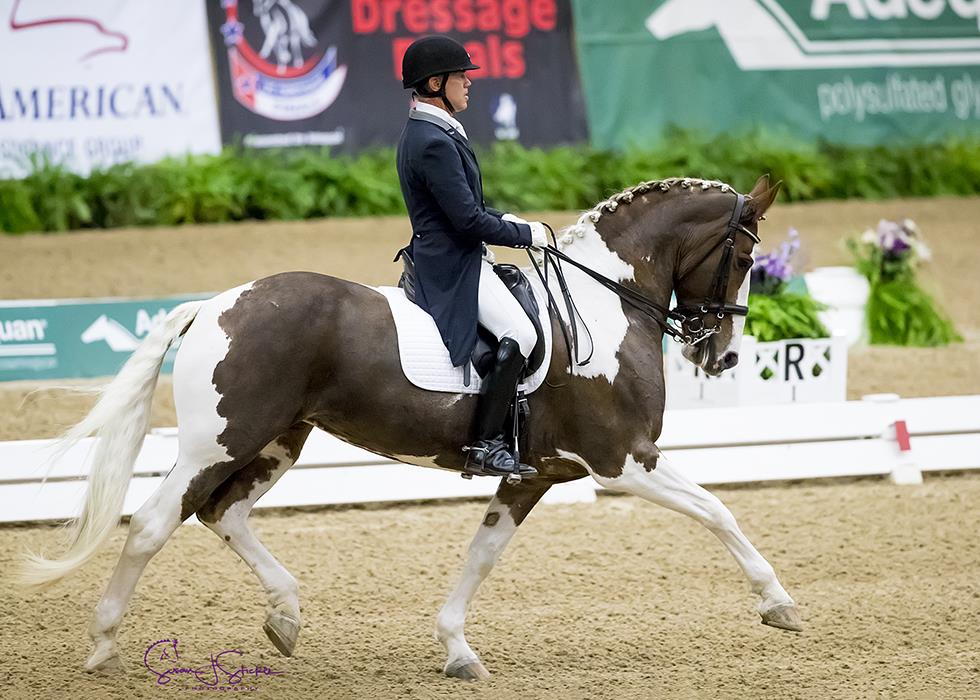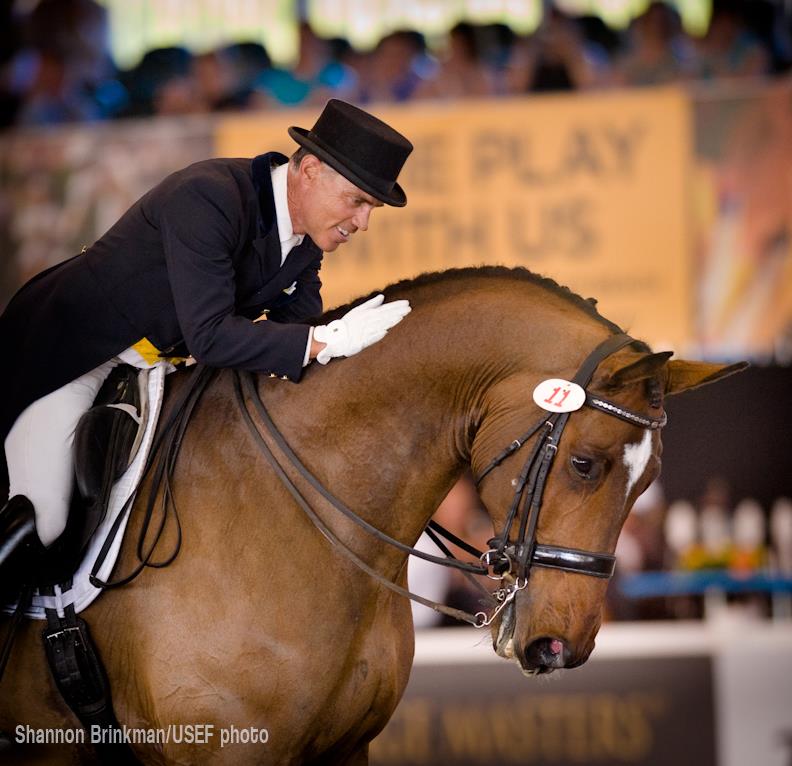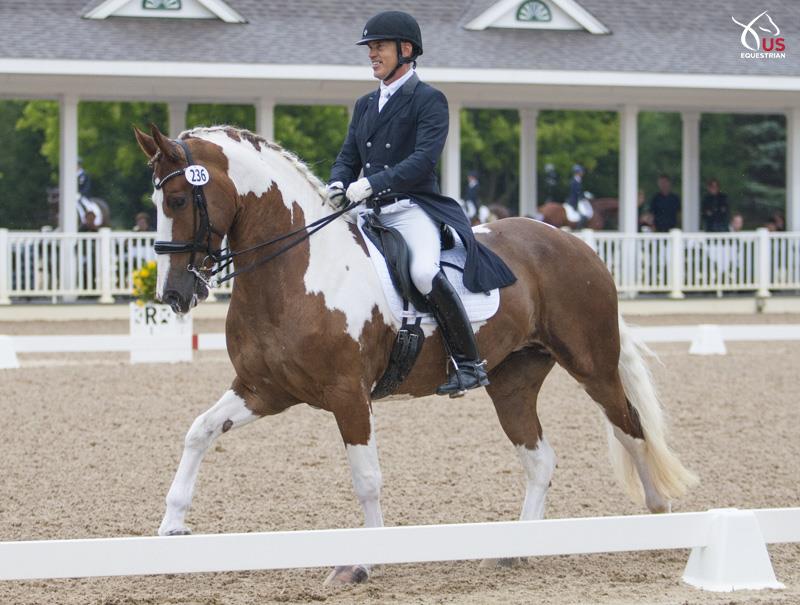Adiah HP just loves to dance. That’s how her trainer and rider Jim Koford puts it. “It’s physical, and it’s exciting, and you have to stay on your game!” Koford said of partnering Adiah in the dressage ring.

Their joy in performing is obvious—you can watch their winning performance in the Grand Prix Open Freestyle championship at the US Dressage Finals presented by Adequan® here—and, Koford says, dressage can bring that kind of fun to any horse and rider combination.
“You can have a great day or you can have a day where the schooling isn’t going as well as you had hoped, but it’s not ever a bad day, because it’s all part of the process,” Koford said. “We’re all trying to grow as people, and the horses really are part of that personal growth. If you get frustrated and the training isn’t going as fast as you’d hoped or as well as you’d hoped, well, that’s just your stuff, and you need to toss that aside and let the horse direct where you’re going and the path you’re on.”
That path might lead to the dressage ring or it might lead somewhere else. Koford’s philosophy: embrace the journey and celebrate the diversity. Whether you’ve got a palomino Shetland pony, a black Morgan, or a pinto Friesian-cross, Koford’s advice is to try taking them dancing.
What Friesians Bring to the Ring
Adiah, Koford’s partner at US Dressage Finals, is cut from somewhat unusual cloth. She’s three-quarters Friesian and one-quarter Dutch Warmblood, but, as Koford explains, this wasn’t a random cross.
“Friesians have an amazing talent for piaffe and passage. There are some lines that are specifically for driving, but they’re also breeding them more for sport and dressage now, too,” he said. “I think Friesians and Friesian crosses have a very valid contribution to the sport of dressage. There are so many breeds that can be used for the sport of dressage and can be competitive. I love the idea of purpose-breeding, but purpose-breeding doesn’t necessarily have to come from European breeds or the ‘traditional’ breeds. I’ve really enjoyed working with different breeds.”
Adiah’s sire, Nico, was a black-and-white half Friesian and half Dutch Warmblood. Koella and her husband Jon bought Nico from Harry Witteveen in Ontario, Canada, and bred Adiah from their Friesian mare Marije Ant.
“The pedigree looks unusual, but Adiah has some very, very good sport Friesian lines,” Koford said. “The stallion has actually had an amazing number of offspring that are doing Grand Prix. He’s been bred to Trakehner mares, to Arab mares, to Friesian mares—his foals just seem to have an aptitude for it. It’s really fun.”
Tragically, Nico died in 2010 in a barn fire at Sherry and Jon Koella’s boutique Hidden Promise breeding farm in Tennessee. The fire killed five horses and destroyed two barns in the early morning of Christmas Day, but Adiah—then a 3-year-old—and a few others survived. Adiah, luckily, had been in her pasture overnight.
Koford, who had worked with Nico for the Koellas, started riding Adiah about 18 months ago.
“She came into a clinic I was teaching and she just oozed confidence and flamboyance,” Koford said. “She sparkled. And I still get that. I ride her, and my whole body is tingly, because it’s like this energetic exchange. It’s really fun, and it’s hard to come down off it.”
Finding a Horse’s Hidden Talents
Koford said that his approach with Adiah was “to cultivate her enthusiasm,” and to do that he took an unusual path.

“I didn’t think doing a traditional First Level, Second Level, Third Level, Fourth Level with a year at every level was at all in line with her,” he said. “She just wanted to dance. This one told me she wanted to be famous.”
Instead of taking the traditional route through the levels, Koford put Adiah in exhibitions “so that she could go in the ring and people would clap, and she could dance,” Koford said. “My goal post this year has been to introduce all the stuff we were doing at home, to try to introduce the more difficult exercises in a venue that was fun and that could give her a lot of positive affirmation.”
That, rather than riding the perfect corner or worrying over a sloppy transition or a wavering line, became Koford’s priority with Adiah in 2017. It was an unusual approach, but it paid off in the freestyle at US Dressage Finals.
“She heard the applause from the horse before her, and she was like, ‘My people are calling!’ I felt her dragging me down the tunnel into the ring,” Koford recalled. “It made me feel like a proud parent, because she just wanted to be on stage.”
But Koford admits his US Dressage Finals experience with Adiah wasn’t totally carefree. “I was really suffering from competition nerves, because I just felt like, ‘Oh, my gosh, this sweet, wonderful horse that I have cultivated so carefully—I just wanted to protect her from people who might be dismissive of her or her abilities—but what was I thinking? I should have gone down a level.’ I didn’t want all these judges seeing her before she was ready.”
So how did he steel his nerves?
“This is sort of embarrassing, but I guess everyone has their own way of dealing with competition nerves,” Koford said. “We did a cowboy-themed freestyle, so I put on a sheriff’s badge and a bolo tie underneath my tie, and I thought, ‘All right. Now I’m performing. I got into character, and then, instead of being afraid of the judges, I was like, ‘Look at this! Is this not the coolest horse ever?’ It was just like an exhibition. And it took any competition stress away, and there I was, on the funniest, happiest horse, and isn’t she fun?
“My strength is not on the perfect, elusive, 20-meter circle,” he added. “Mine is much more of a sensory experience: wow, feel the power! Feel the swing! Feel the elasticity!”
Dressage: A Language for Everyone
Thinking creatively like this is vintage Koford, and there’s a serious philosophy behind it. Koford encourages horse owners of all disciplines, and regardless of their horse’s breed, to consider trying a little dressage to see what potential it might unlock.

“I’m sort of a blue-collar trainer, and I’m always coloring outside the lines,” he said. “I have an eclectic group of horses in my barn, and I just enjoy their personalities. It’s amazing the hidden talents the different breeds have. Just because your horse isn’t suited for the FEI Young Horse classes in no way limits their potential to be a Grand Prix horse. I love tinkering with the horses and seeing if we can do Grand Prix on them.
“I’m really fortunate to have a lot of horses like Adiah who have a little twinkle in their eye and something special to offer. I don’t put any self-imposed limits on them, like ‘This horse is only going to be Second Level’ or ‘This one is only going to be Prix St. Georges’ based on their movements. I think everybody has a secret, and every horse has hidden talents. It’s really fun to start with no expectations and just explore, cultivate what they have, and let it blossom. Every horse isn’t going to make Grand Prix, but it’s really fun to introduce the exercises and play with it under a non-stressful situation and see how they respond to the training.
“Whether or not you choose to compete in the sport of dressage, it’s really good training,” Koford said. “There are so many good tools that we use in dressage that apply to every discipline. It’s not just an arbitrary set of exercises. Having the basics of dressage is something that can be so important for every horse and rider, and it’s not something like you have to take your vitamin pill or you have to floss your teeth. It’s just fun to train your horse and have them understand. It’s fun to teach them lessons about how to use themselves more efficiently and to tap into their power so that they really learn to swing in the trot and to really let go and to bend. The basics are like doing a flow yoga class. It’s just fun to get that intimately connected to your horse and their movement and how they’re thinking. It gives you a heightened sense of awareness when you’re riding, and it gets you to a different place, mentally. It’s a very Zen place.”
To learn more about the sport of dressage, visit the United States Dressage Federation and US Equestrian’s dressage page. To learn more about Friesians, visit the International Friesian Show Horse Association, US Equestrian’s Friesian page, and our free Learning Center video about US Equestrian’s 29 affiliated breeds and disciplines.
Want more articles like this delivered to your inbox every week? Sign up here to receive our free Equestrian Weekly newsletter.
This article is original content produced by US Equestrian and may only be shared via social media. It is not to be repurposed or used on any other website aside from usequestrian.org.


